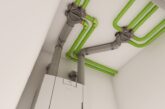
Parex provides a guide to transforming a home’s exterior with render.
Render has undergone a resurgence in recent years and has become the façade material of choice for many specifiers wanting to create a fresh new exterior on contemporary or traditional homes. Available in a wide range of finishes and colours, it can not only transform exteriors but will also provide protection from the elements and make a building more energy efficient. By taking on board some of the top tips when it comes to the specification and installation of render systems, this will ensure your chosen solution best suits your requirements, whilst at the same time creating a stunning exterior.
A range of renders
From through-coloured, one-coat renders to traditional heritage lime renders, mineral and acrylic renders, and wrap-around External Wall Insulation (EWI) systems combining renders with external wall insulation, there are a number of rendering products which can be used on site and on a multitude of substrates.
The right finish
When specifying render and façade systems, colour and texture will vary depending on the type of finish or solution selected whilst the application method, such as a scraped hand finishing or a machine sprayed textured finish, can have a noticeable effect on the appearance.
Lime renders have also become the fashion in recent years, not least due to their added breathability and versatility, but on account of the fact they add distinctive character to new buildings, as well as in the restoration and decoration of traditional buildings. Parex’s one-coat renders are available in a standard range of 48 colours and can be used to complement the hues and colours of a wide range of building types and to create a range of smooth, textured and patterned finishes. When used in combination with a broad range of insulation types, mineral and acrylic renders offer the specifier a wide range of dash and specialist finishes which are both decorative and highly durable.
Application
One-coat renders such as Parex Monorex GM are suitable for both manual and spray-applied applications. A spray-applied render is ultimately faster and more efficient than the traditional hand-applied method and provides a crisp, clean finish on a wide range of substrates. To avoid shade variations always apply and finish the render application to whole elevations at the same time.
![]()
Preparation
The preparation of the substrate prior to applying a render is key as it will impact the overall performance of a render system. Walls should be surveyed and structural defects rectified prior to the application of a render system. All surfaces must be clean, suitably dry, sound and free from anything that may interfere with the adhesion of the material to be applied. In the case of wet and patchy substrates, it is recommended that an enhanced key coat is applied and then dried for 48 hours prior to the application of the finishing coat.
Approved applicators
This is a skilled profession so the best advice is always use a professional. Failure to do this can lead to building defects due to poor installation and workmanship. It’s why manufacturers of building products have established approved applicator schemes in order to provide comprehensive training for contractors using their products and can play a part in quality control and the minimisation of defects.
Planning permission
Whilst rendering work must comply with building regulations, planning permission is not normally required to render a house if the materials are of a similar appearance. However, for homes that are listed or located in conservation areas, planning permission from the relevant local authority should be obtained.
Available in a wide range of styles, finishes and colours, rendered façades are a versatile, efficient and cost-effective system for any building regardless of the type or age of construction. They have the potential to improve the outer skin of a building, update the aesthetics, adding limitless kerb appeal and are an important step in improving a building’s long-term thermal efficiency
For more information about the wide range of Parex render systems, or for technical guidance visit https://www.parex.co.uk/Render_Systems







